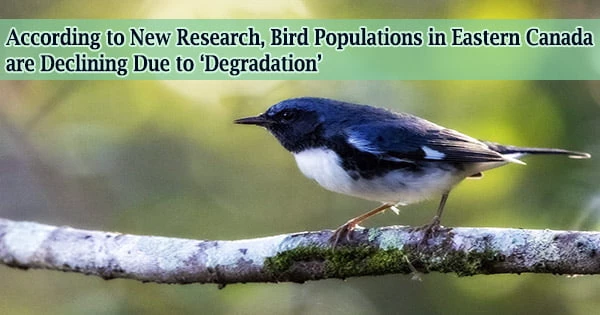According to recent research performed by Oregon State University that quantifies the effects of forest “degradation” on avian habitat, bird species that reside in wooded areas are under threat from human-caused changes to forest composition.
“Reducing forest loss has been the main focus of conservation policy to date, which is well justified because it has a strong negative effect on biodiversity,” said Matt Betts of the OSU College of Forestry.
“But the effects of changing the composition and age of forest via timber management have traditionally been very difficult to measure at large scales and thus have been largely ignored. Our work shows population declines in many bird species in eastern Canada are due to habitat loss caused by forestry activities.”
The findings of Betts’ worldwide partnership were published in Nature Ecology & Evolution today.
The researchers looked at how forest degradation, such as clearcutting and subsequently thinning or replanting single tree species, affects bird habitat and long-term trends in bird populations.
The Acadian Forest in Canada’s maritime provinces served as the research site. From 1985 to 2020, 66 percent of the forest’s 54 most common bird species lost breeding habitat, which was closely linked to the loss of older forests, according to the study.
The golden-crowned kinglet and Blackburnian warbler were the species with the most habitat loss, with seven species in all reporting habitat losses of more than 25%.
Reducing forest loss has been the main focus of conservation policy to date, which is well justified because it has a strong negative effect on biodiversity. But the effects of changing the composition and age of forest via timber management have traditionally been very difficult to measure at large scales and thus have been largely ignored. Our work shows population declines in many bird species in eastern Canada are due to habitat loss caused by forestry activities.
Matt Betts
Long-term bird population decreases were closely connected to habitat degradation, particularly for species that live in ancient forests. Over the 35-year study period, the researchers estimate that between 33 and 104 million birds died as a result of forest degradation.
The scientists discovered that nine bird species in the study area have fallen by more than 30% in the last ten years, meeting the threshold for listing as threatened under Canadian endangered species legislation.
“Due to increased global demand for wood, more and more of the Earth’s surface is being used for timber extraction,” said Betts, the lead scientist for the HJ Andrews Long-term Ecological Research Program.
“This shows up on remote sensing as both forest loss and forest gain, but unfortunately the ‘gain’ is often vastly simplified, young forest. Our paper presents a new way to quantify these sorts of changes.”
Betts and colleagues from Cornell University, the University of Rhode Island, the University of New Brunswick, Google, and a number of Canadian and American agencies used satellite imagery, breeding bird survey data, and species distribution models to look at forest and bird population patterns.
The Acadian Forest, which is recognized for its diverse tree species, has showed widespread signs of decline in the last three decades, according to Betts. Over 3 million hectares of the Acadian Forest have been clearcut since 1985, and much of it is now dominated by single tree species or a mix of early successional species.
“Old forest declined by 39% over the period we observed,” Betts said. “Over the same period, forest cover actually increased by a net 6.5%. That pattern of extensive harvest of old forest, followed by rapid regeneration of young forest and then subsequent harvest before maturity is attained, seems to be common in many forest regions of North America and northern Europe.”
He claims that managed forests are dominated by one or two merchantable tree species, and that they are also younger than those that would emerge naturally, such as through fires or windstorms. This could have consequences for species that live in mature or old-growth forests.
According to Betts, quantifying the effects of forest degradation is especially crucial in light of recent conclusions by the Intergovernmental Panel on Biodiversity and Ecosystem Services that indicate the earth is facing a biodiversity catastrophe.
“Clearly the research by Betts and collaborators identifies one of the critical smoking guns of avian declines,” said Peter Marra, the director for Georgetown University’s Institute for Environment and Sustainability and a co-author of the recent Science paper on bird declines.
“We’ve assumed once a natural forest is cut down, as long as you plant more trees all the rest of the plants and animals will fill back in. The new research shows that’s not the case.”
Deforestation and permanent conversion to another land-cover type were not a key driver of habitat loss in the Acadian Forest, according to Betts, accounting for less than 2% of all habitat loss among the 54 bird species studied.
“Overall, our findings indicate broad-scale declines in forest birds of the Acadian Forest, and for most species, abundance is strongly associated with habitat amount,” he said. “We expect that similar consequences for biodiversity are in place for intensively managed forests in other parts of the world as well. If all you look at is forest cover, you’ll miss the more subtle but critically important role of forest age and type in maintaining biodiversity.”
The Environment and Climate Change Canada Climate Nature Fund supported this research. The collaboration included scientists from the New Brunswick Department of Natural Resources and Energy Development; Canada’s National Wildlife Research Centre; the Ontario Ministry of Natural Resources and Forestry; and Google Earth Engine.





